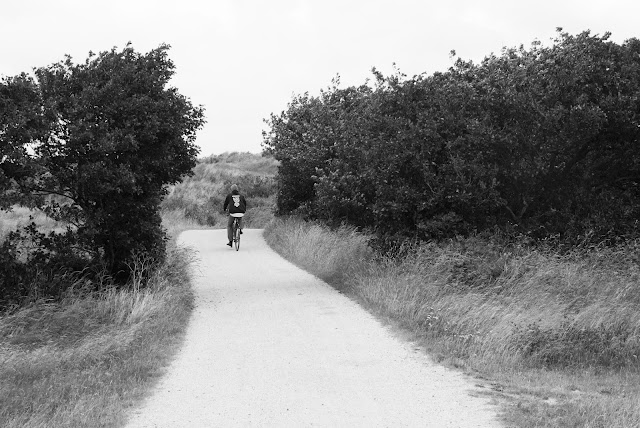One week ago I was cycling in the open landscapes of Terschelling. I found what I was looking for and was convinced that being out of the mainland, being landed in a small island, was the place I needed to be during those days. After crossing the mysterious waters separating the Wadden Islands from the long coastline of the Netherlands, I felt free and open while cycling around with my friends. Clouds were hanging low above our heads and the challenge of the hard wind was bitter sweet. I think nothing else than the roam of the sea and the open horizons on our way, could empty our heads better from the echoes from our everyday life. Following the sand without any marked roads on our beach walks, it was like slowly getting closer to the hidden edge of the civilization.
At the same time I was aware that the local people must have their own story to tell about the life in the island. These people must have their unique way to sense the spirit of this landscape. The strong winds, the noise of the sea and being so close to the nature must have had a big influence on the character of these people.
During the history the western and the eastern part of the island were separated. There has been some characteristic differences between the people of the opposite ends of this island. In the west, the people were more connected to the sea and the folks in the East were more connected to the earth and farming. Nowadays is more like a one island and the main income comes from the Tourism during the high season. Visiting places like this and sensing the isolation, like a timeless comforting mist around the island, make me feel a bit protective. I felt like not wanting to disturb the balance of the nature and the life of the Island people. Well, I was not in a jungle with some tribe :), but I felt a big respect to this beautiful place and the people making their living in here and being part of the story. I felt so happy being able to be there this summer again.
 |
| Great, old architecture in West Terschelling. |
 |
| Terschelling from the air, west end in front. |
This was my second visit on this island and I was taking part to Oerol festival with my husband and with my friends. I felt fascinated about the spirit and the creativity of the theatre and the music performances I saw. The most impressive element in this festival is how they manage to include the nature so closely to the performances. After cycling to the theatre location, you are often guided to the middle of the dunes or woods through the small paths in the Nature. In these silent locations, the message of the performance feels very intimate. You never know if the sun is going to shine or if there are rain showers during the show. But it doesn't matter, people seem to be more ready the accept the situation and the moment...as it comes. The forces of the nature are like surprising elements in this festival. I also like how the theatre is bringing up the environmental and human issues of our time. The whole concept of shows is very modern and the actors and the musicians are spontaneous in always changing situations, connected with the nature.
Some great performances we saw:
Billy the Kid
Orkater: De wereldvergadering
Saman Amini: samenloop van omstandigheden
One day we cycled to the East end of the island. Actually you can't really cycle through the most eastern part of the dunes, the better way is to park the bike and walk the rest along the huge coast line. So we cycled first through the cycling path in the de Boschplaat, which is one of the European Nature reserves. After parking our bikes, we headed to the beach.
It looked so fresh and clean at the beach, but of course the sea had floated some plastic on the sand. We collected some garbage on our way and I was thinking all the garbage floating on the sea all over the world. We can read so much over this issue at the moment and there are some well known projects like The Ocean Cleanup trying the make the difference by collecting the big garbage patches from the Oceans. The ocean currents are bringing the plastic garbage to 5 different locations in the Oceans of our planet. I think it is important to read about these issues and try to use less and less plastic in our daily lives. This is quite a challenge for example when doing the shopping in a supermarket, but we have to learn to be more aware when making the choices and show a good example to the next generations.
Summer greetings from sunny Amsterdam, with many island memories!















